Ancient Romans often said: tempus fugit — time flies. And in its passing, it devours all things. However, in Mérida, Spain, history still feels alive. This city, a UNESCO World Heritage Site, is a living museum of Roman grandeur, with ruins so well-preserved they transport you straight to the era of emperors and gladiators. In this comprehensive guide, I share my art history and archaeology expertise, along with insights from three visits, to help you explore Mérida (Spain) Roman ruins and also discover more fascinating ruins near Mérida. Packed with history, tips, and inspiration, this guide is your ultimate resource for planning an unforgettable journey through the Roman Ruins near Mérida Spain.
This post may contain affiliate links. If you make a purchase through these links, we will earn a small commission at no additional cost to you. We recommend products we have personally used or verified. Read the full disclosure here.
Don’t have time to read the whole article? Here is the best Mérida day tour! Find the top Mérida hotels!
Pin this for later!
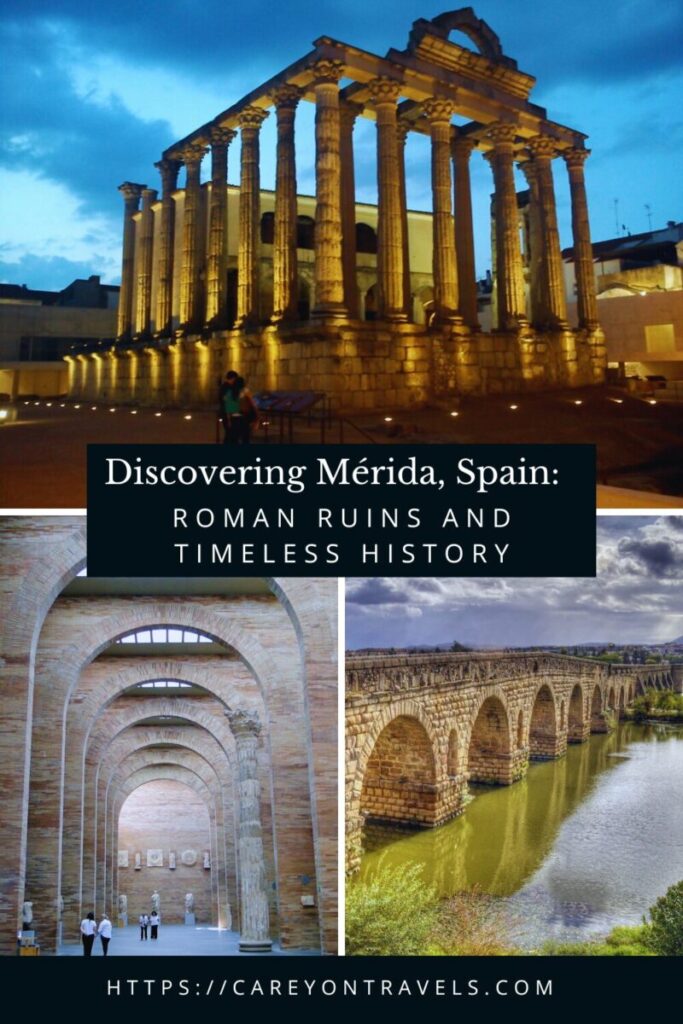
Are the Roman Ruins in Mérida Spain Worth Visiting?
Absolutely! Mérida offers a unique journey into ancient history, far removed from Spain’s bustling cities and scenic coastlines. This city is a treasure trove of Roman wonders, blending the past with a vibrant modern vibe, making these some of the must-visit Roman Ruins in Europe. Mérida’s compact, walkable city center lets you effortlessly roam between its ancient ruins and vibrant modern attractions.
Picture yourself walking through a Roman theatre where actors once performed or crossing the Puente Romano, which has spanned the Guadiana River for nearly 2,000 years. Mérida’s Roman ruins are so well-preserved, they feel alive, making it a dream destination for history lovers.
But Mérida isn’t just for history buffs. It’s also known for its warm hospitality, delicious local cuisine, and relaxed pace of life. These invite all travelers to slow down and soak in the charm. Whether you’re marveling at the Roman ruins in or near Mérida, Spain, this city promises an unforgettable experience.
A Brief History of Mérida, Spain
Mérida’s story begins in 25 BC, when Emperor Augustus founded Emerita Augusta as a home for retired Roman soldiers. As the capital of Lusitania, a vast Roman province covering parts of modern-day Spain and Portugal, it thrived as a center of trade, culture, and administration. The Merida’s Roman ruins still reflect this golden age, showcasing monumental theaters, temples, and bridges.
But history didn’t end with Rome’s decline. Mérida evolved through Visigothic and Moorish eras, each leaving a unique imprint. The city’s streets and monuments tell a layered tale of civilizations, from Roman grandeur to Moorish fortifications.
The Roman ruins near Mérida, like the Proserpina Dam and Alange Roman Baths, offer even more insight into the region’s rich past. Together, these landmarks make Mérida a vibrant mosaic of history and a must-visit destination for travelers.
What to Read Before You Visit Europe’s Roman Ruins
Before embarking on your journey to explore the Roman ruins in Mérida, immerse yourself in the history and culture of the Roman Empire to enhance your experience. A highly recommended resource is The Penguin Historical Atlas of Ancient Rome, which provides a comprehensive overview of the empire’s rise and fall, complete with maps, timelines, and key historical insights. This book helps you visualize the vast network of Roman roads, cities, and territories, offering context for the ruins you’ll visit. For a deeper dive into Roman daily life, consider SPQR: A History of Ancient Rome by Mary Beard, which vividly recounts the empire’s social and political landscape.
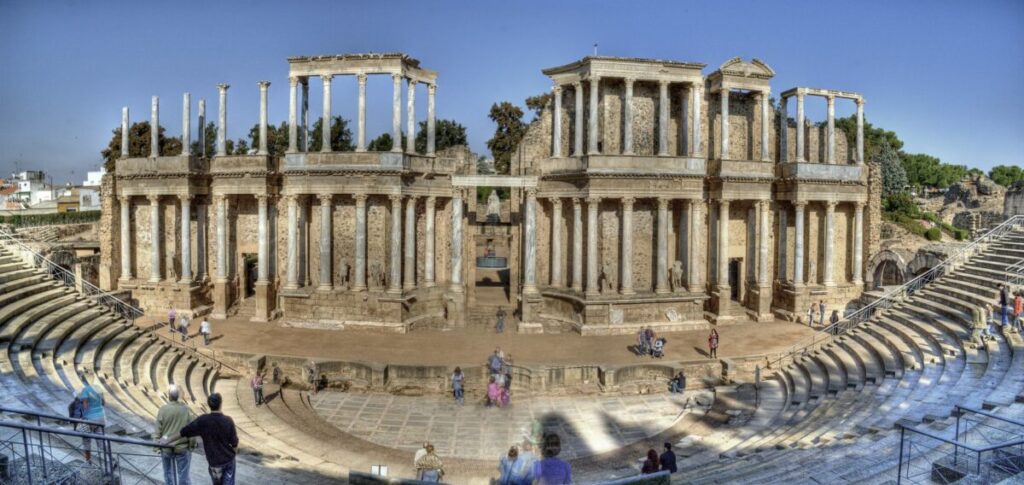
Mérida Spain Roman Ruins Highlights
- Discover Mérida’s Roman Ruins: A Walking Tour Through Time
- Roman Bridge: Mérida’s Timeless Gateway
- Roman Dam: A Flood Defense Masterpiece
- Arch of Trajan: A Grand Entrance
- Temple of Diana: Mérida’s Architectural Crown Jewel
- Forum Monument: The Heart of Ancient Mérida
- National Museum of Roman Art: A Treasure Trove of History
- Amphitheater House: A Glimpse into Roman Luxury
- Roman Amphitheater: Gladiatorial Glory
- Roman Theatre: A Stage for Grandeur
- House of the Mithraeum: Discover Roman Luxury
- Roman Termae: Bathing the Roman Way
- Roman Circus of Mérida – The Largest Entertainment Venue
- San Lázaro Aqueduct – A Testament to Engineering Excellence
- Aqueduct of Miracles – A Scenic Roman Wonder
- The Water Castle – The Heart of Roman Hydraulics
- Discover the Best Ruins Near Mérida: A Journey Beyond the City
- Mérida, Spain Roman Ruins Travel Tips
Discover Mérida’s Roman Ruins: A Walking Tour Through Time
Mérida, Spain, is a treasure trove of ancient wonders. Its Roman ruins are seamlessly woven into the city’s vibrant streets and plazas, inviting visitors to step back in time. If you’re exploring ruins near Mérida, this walking tour is your ultimate guide to the city’s most remarkable relics. For those preferring a guided tour, there are a number of walking tours available.
1. Roman Bridge: Mérida’s Timeless Gateway
Kick off your journey with a stroll across the Puente Romano, an engineering marvel spanning the Guadiana River. Built in the 1st century BC, this iconic granite bridge is the longest surviving Roman bridge in the world. Its 60 elegant arches stretch over 790 meters (ca. 2,592 feet), making it both functional and beautiful. Today, the bridge serves as a pedestrian pathway, offering breathtaking views of the river and the city.
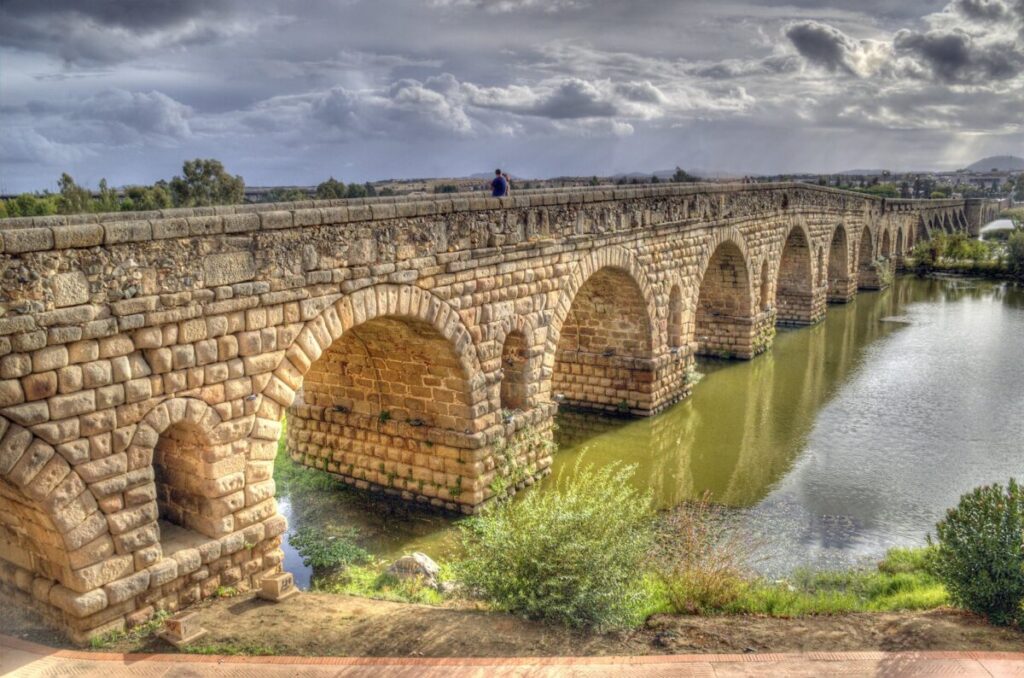
2. Roman Dam: A Flood Defense Masterpiece
Just beyond the bridge, discover the Dique Romano, a robust Roman dike that safeguarded the city from flooding. Stretching along the right bank of the Guadiana, this wall is a testament to Roman ingenuity in hydraulic engineering. Its hefty ashlar base and masonry superstructure not only controlled floodwaters, but also supported the city’s sewer system.
Fun fact: the dike also protected burial grounds and small industries that lined the riverbank during Roman times.
Today, part of the Dique Romano integrates with the Alcazaba’s riverside walls, blending seamlessly into Mérida’s layered history. Stroll along this section to appreciate its strategic brilliance and the Romans’ ability to tame nature’s forces.
3. Arch of Trajan: A Grand Entrance
Next, make your way to the towering Arco de Trajano, a 15-meter-high (ca. 49 feet) granite arch that once welcomed visitors to a sacred Roman precinct. Built in the 1st century AD, this majestic gateway is a true showstopper. As you admire its weathered stones, imagine the awe it must have inspired in ancient travelers entering Mérida’s bustling heart.
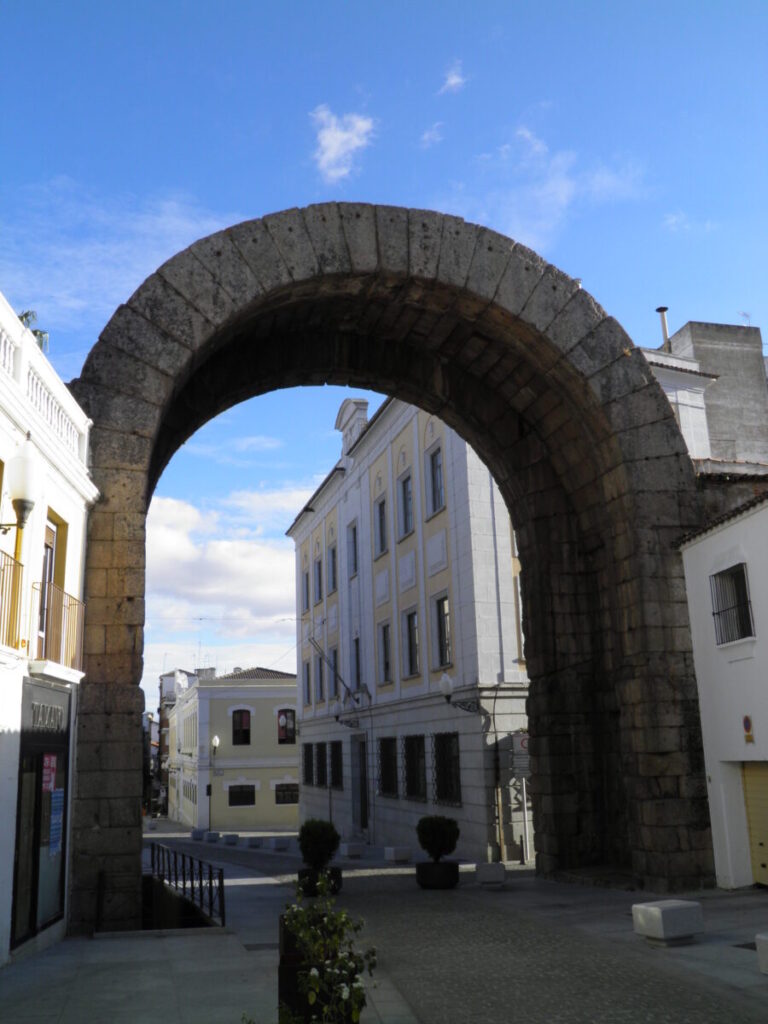
4. Temple of Diana: Mérida’s Architectural Crown Jewel
Next, go to the Templo de Diana, one of Mérida’s most remarkable Roman ruins. This 1st-century AD masterpiece boasts an imposing colonnaded façade and a sturdy podium. Here’s the twist: the temple owes its exceptional preservation to its transformation into a Renaissance palace.
As you admire its Corinthian columns, pause to imagine its layers of history. Once a hub for Roman worship, it later served as a noble residence. Today, it proudly symbolizes Mérida’s timeless allure, standing tall in the city center. If you enjoy Mérida’s Temple of Diana, don’t miss a visit to the Roman Temple in Évora, just across the border in Portugal.
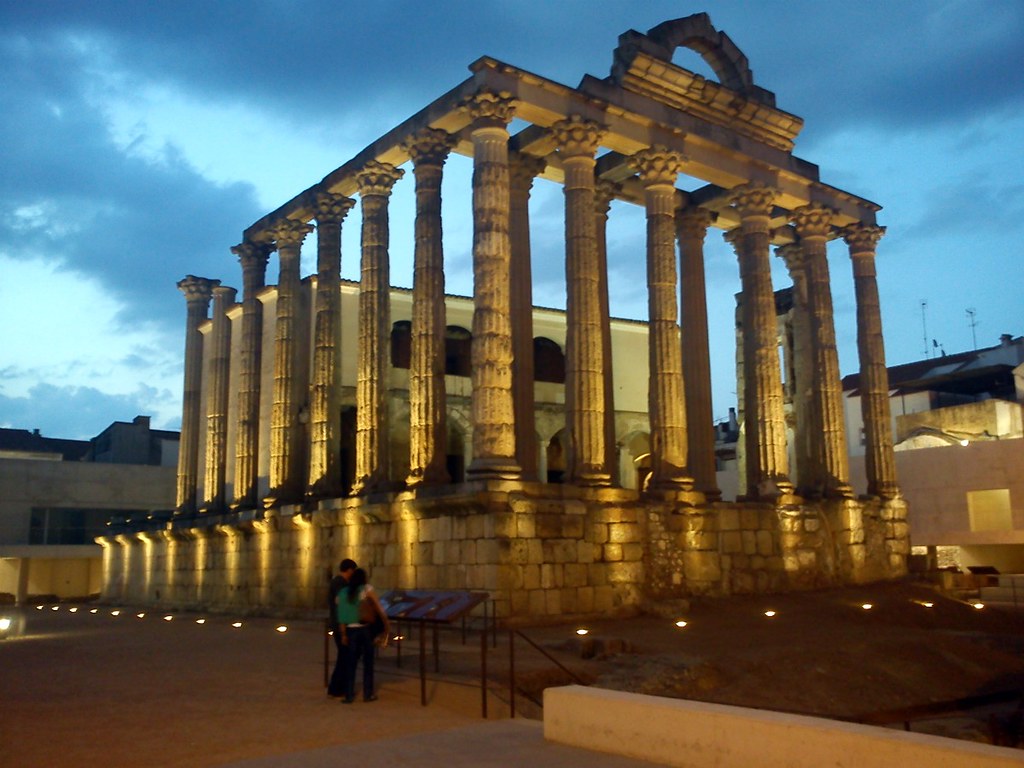
5. Forum Monument: The Heart of Ancient Mérida
Just a short stroll from the Templo de Diana lies the Pórtico del Foro, a fragment of the grand Roman Forum. In its prime, this forum was the administrative and religious heart of Augusta Emerita.
The 1st-century AD structure retains its Corinthian columns and traces of marble cladding, offering a tantalizing glimpse into the city’s Roman grandeur. This spot is perfect for imagining bustling markets and civic ceremonies under the Iberian sun.
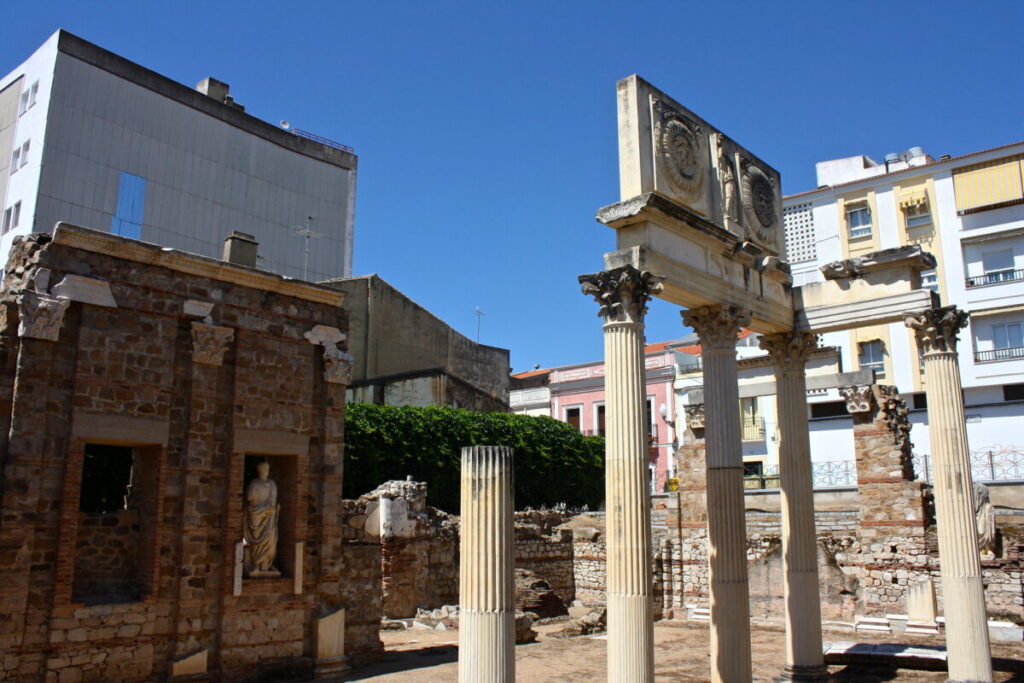
6. National Museum of Roman Art: A Treasure Trove of History
Next, head to the Museo Nacional de Arte Romano, a must-visit for any history enthusiast. This stunning museum showcases the richness of Mérida’s Roman past. From intricate mosaics to statues and everyday objects, each artifact tells a story of life in ancient Hispania. Don’t miss the preserved section of the Roman road that once coursed through Mérida, offering a tangible connection to the city’s illustrious past.
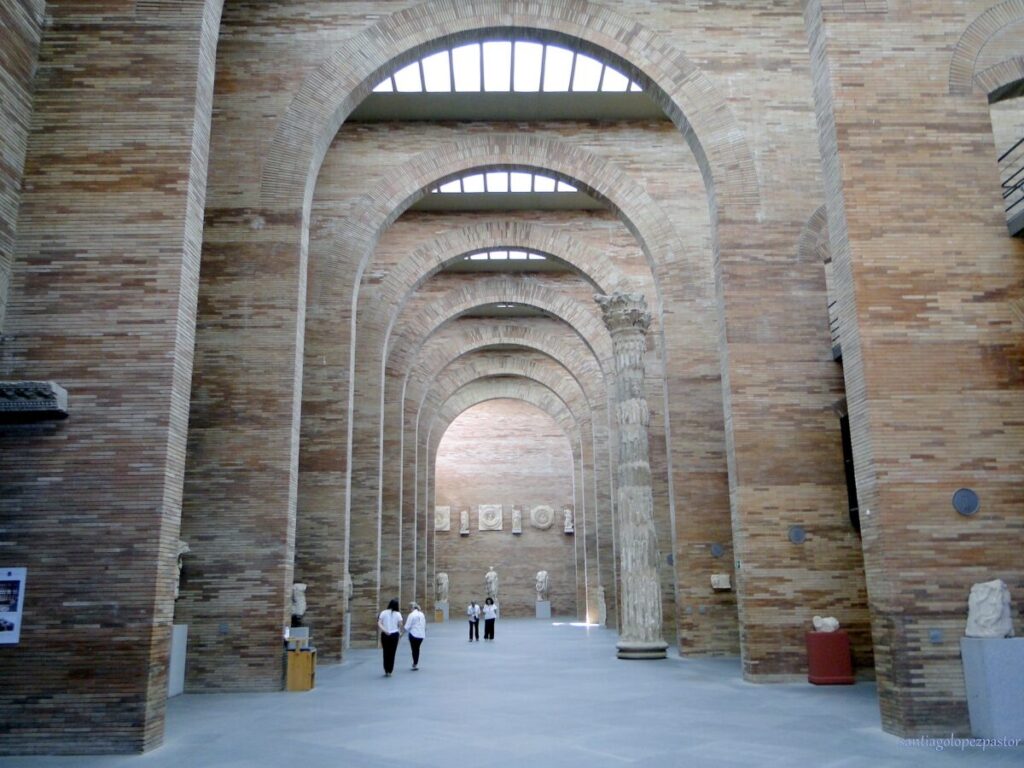
7. Amphitheater House: A Glimpse into Roman Luxury
A short walk away, step into the Casa del Anfiteatro, a stunning example of Roman domestic life. This grand 1st-century AD residence belonged to a wealthy family and features exquisite mosaics, vibrant frescoes, and impressive architectural details. As you wander through its rooms, you’ll feel the whispers of the past and gain a vivid understanding of Roman sophistication and opulence.
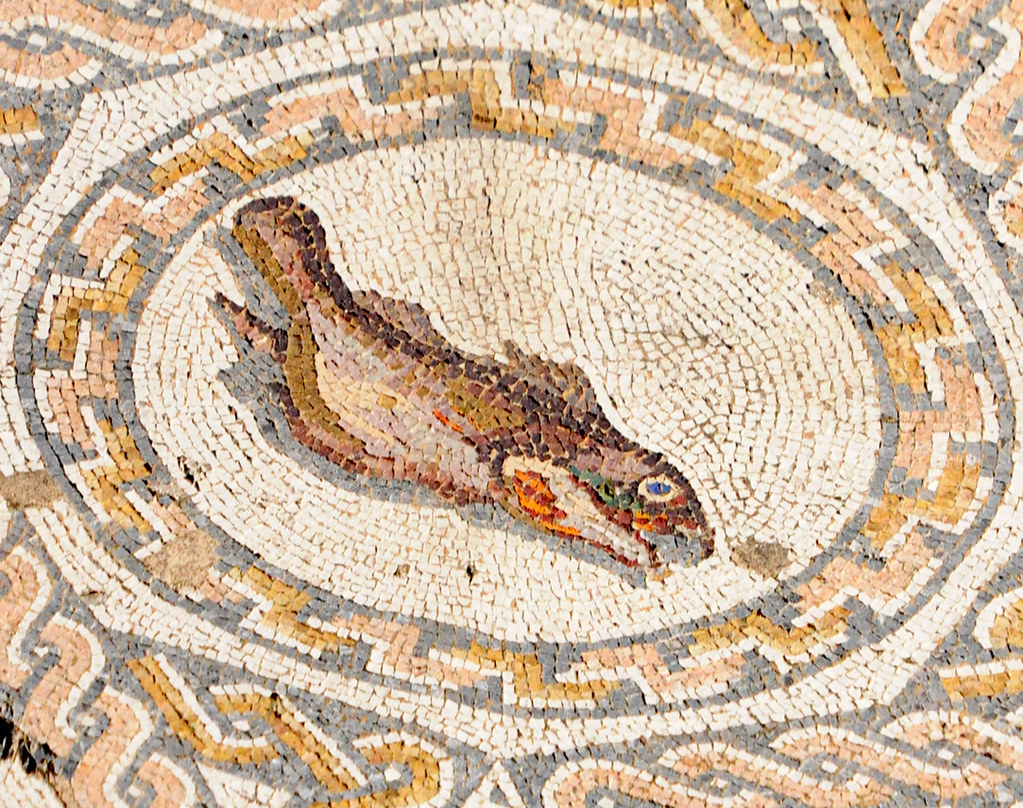
8. Roman Amphitheater: Gladiatorial Glory
Your next stop is the Anfiteatro Romano, completed in 8 BC, which once thundered with the roars of crowds and the clash of gladiators. This arena hosted spectacular events, from wild animal hunts to mock naval battles. Stand in the middle of the amphitheater and imagine the energy of the audience as they watched ancient spectacles unfold.
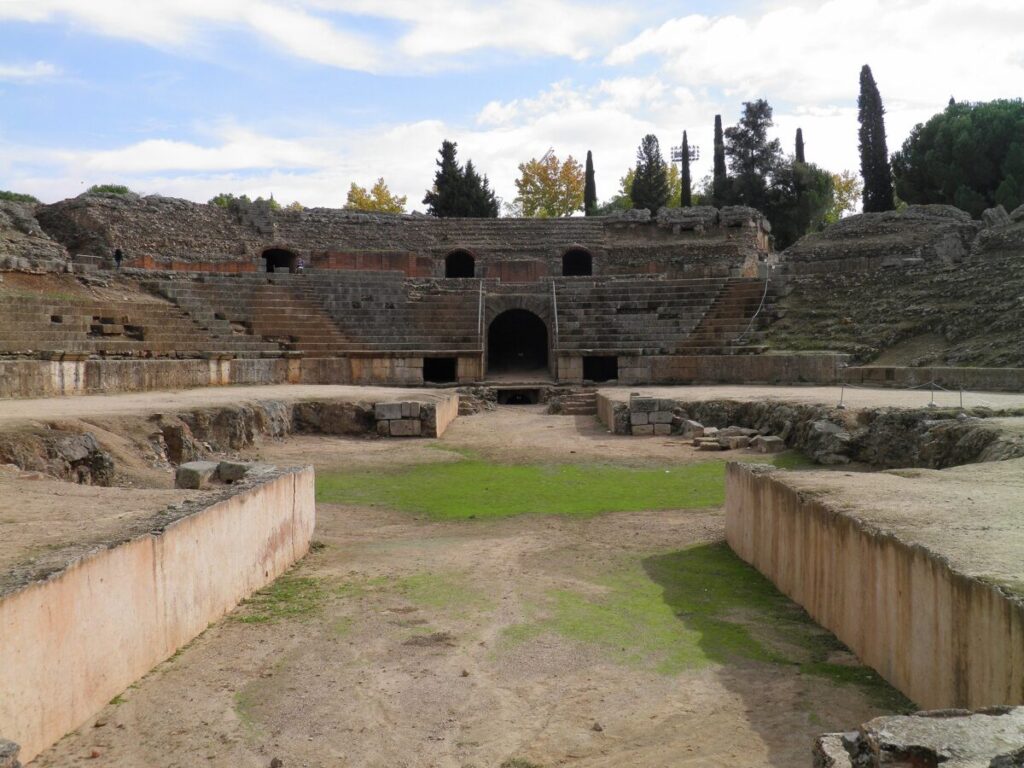
9. Roman Theatre: A Stage for Grandeur
Adjacent to the amphitheater lies the magnificent Teatro Romano, built in 16–15 BC. This ancient theater, one of the finest ruins near Mérida, could host 6,000 spectators for dramatic performances and civic events. Its beautifully preserved scaenae frons (stage backdrop) features intricate columns and statues, offering a glimpse into the grandeur of Roman theatrical art. Take a seat on the stone benches and imagine the buzz of an ancient audience, eagerly awaiting the next act.
Tip: Time your visit with the Mérida Classical Theatre Festival in August to see live shows in the theater.
10. House of the Mithraeum: Discover Roman Luxury
Step into the Casa del Mitreo, a grand Roman villa that offers insight into the opulent lifestyle of Mérida’s elite. The house, named after Mithraic cult artifacts found onsite, boasts the stunning Cosmological Mosaic, a detailed depiction of the Roman universe. This remarkable site showcases the intricate artistry and spiritual beliefs of Roman culture, making it a must-see among Merida’s Roman ruins.
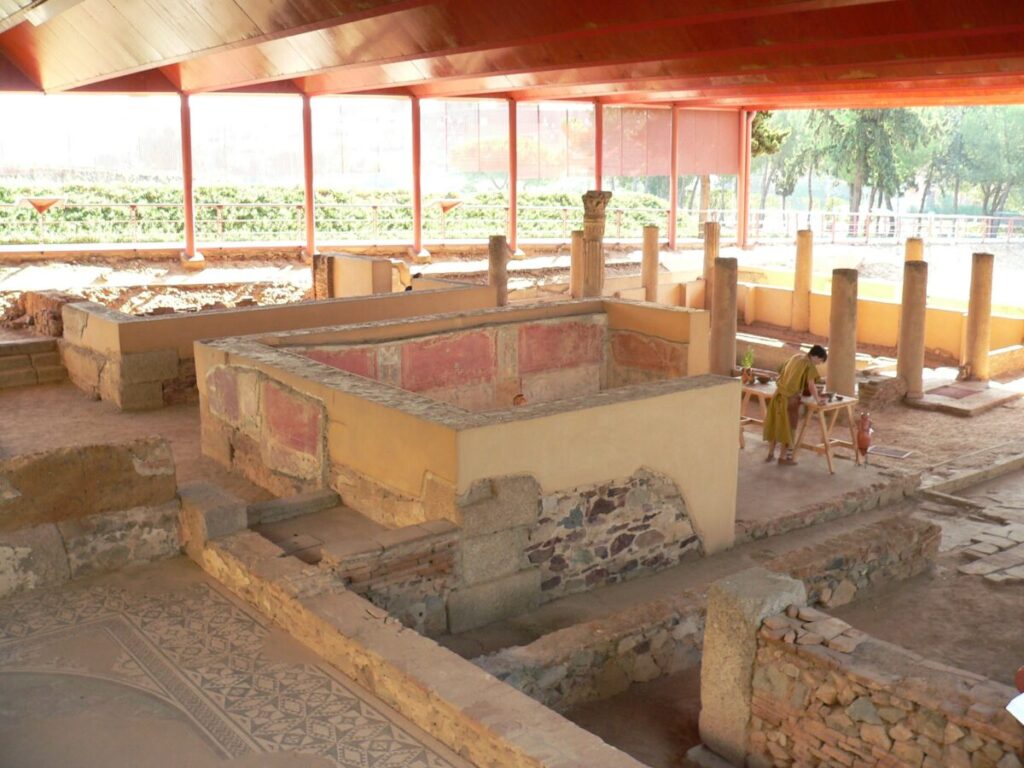
11. Roman Termae: Bathing the Roman Way
The Termas Romanas highlight the importance of baths in Roman daily life. These ancient facilities, scattered across Mérida, served as hubs for relaxation, socializing, and even political discussions. As you explore these sophisticated structures, you’ll gain a deeper appreciation for Roman ingenuity in creating spaces that were both functional and luxurious. The baths are another gem among the ruins near Mérida that reflect the richness of Roman culture.
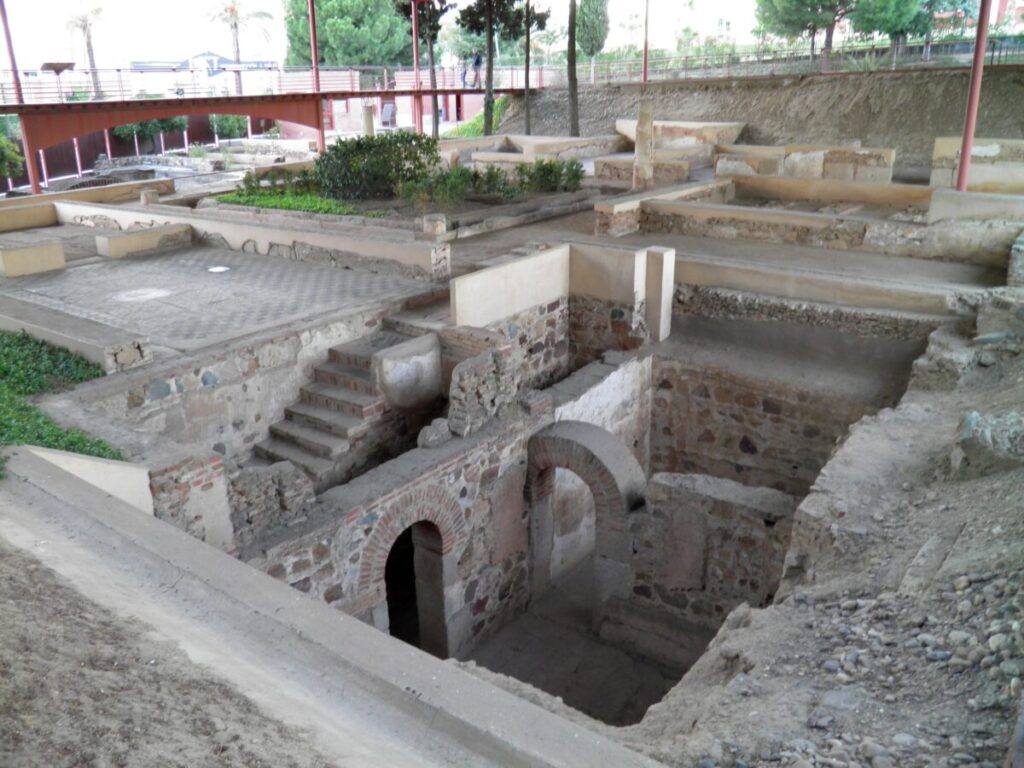
12. Roman Circus of Mérida – The Largest Entertainment Venue
Continue your journey through Roman Mérida with a visit to the Roman Circus, one of the largest and best-preserved of its kind in the Roman Empire. Built in the 1st century AD, this grand arena once hosted chariot races and could accommodate up to 30,000 spectators. Walking through the remains of the long central spine (spina) and seating areas, you can picture the thrilling races and roaring crowds that once brought this space to life. The interpretation panels and the visitor center can offer insights into its history and significance.
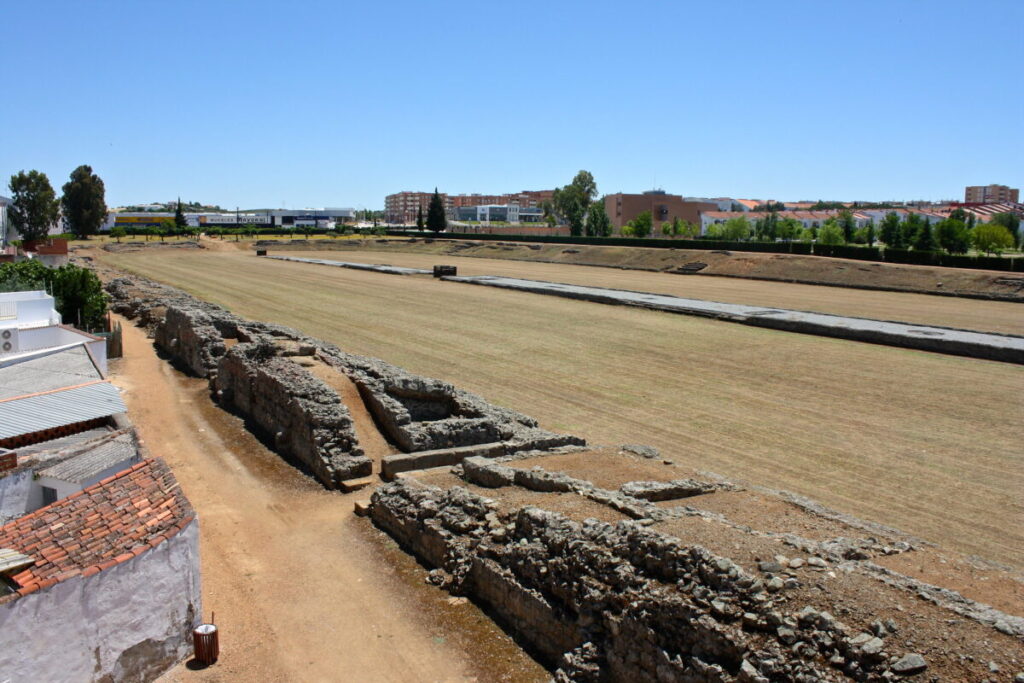
13. San Lázaro Aqueduct – A Testament to Engineering Excellence
From the Circus, follow the path to the Acueducto de San Lázaro, an incredible feat of Roman engineering. Built in the 1st century AD, this aqueduct brought life-sustaining water to Mérida, ensuring its status as a thriving Roman city. Stand beneath its towering arches and marvel at the Romans’ mastery of construction. The combination of beauty and practicality in this structure is a testament to their advanced understanding of water management. It’s no wonder this aqueduct is a star among the Mérida, Spain, Roman ruins.
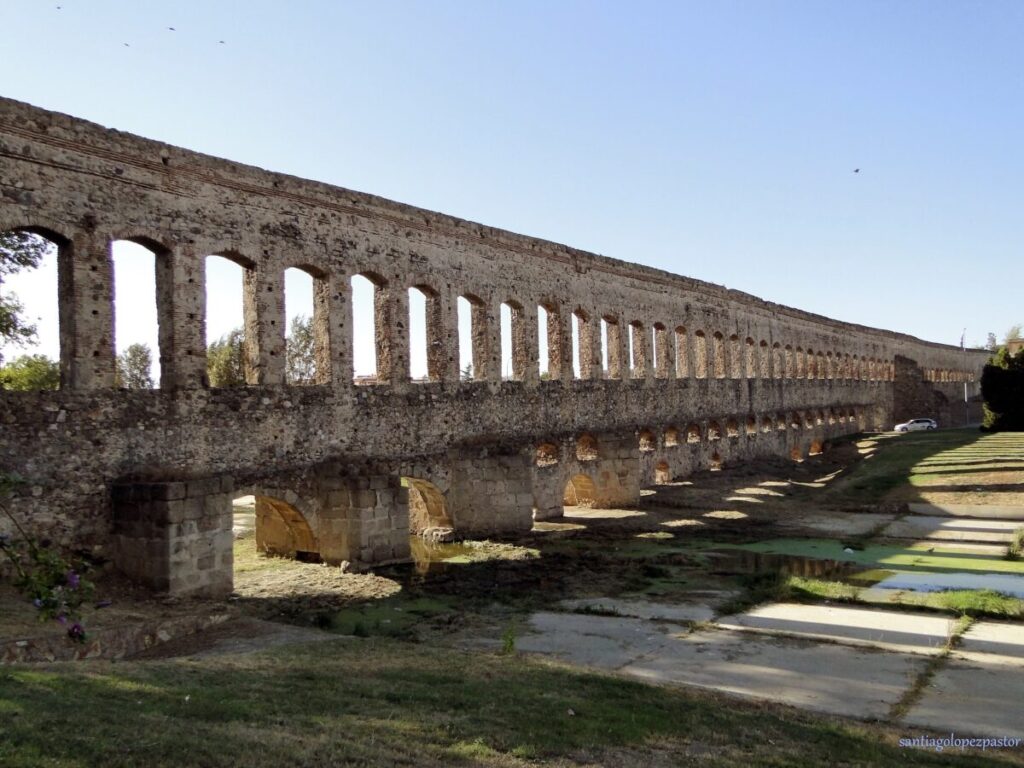
14. Aqueduct of Miracles – A Scenic Roman Wonder
Next, take a scenic stroll to the Acueducto de los Milagros, a striking example of Roman resourcefulness. Built between the 1st and 3rd centuries AD, this aqueduct carried water from the Proserpina Dam to Roman Mérida. Its dramatic arches, a mix of granite and red brick, create a picturesque scene that’s perfect for photography. Imagine the flow of water through these ancient channels as you admire the craftsmanship of this enduring structure.
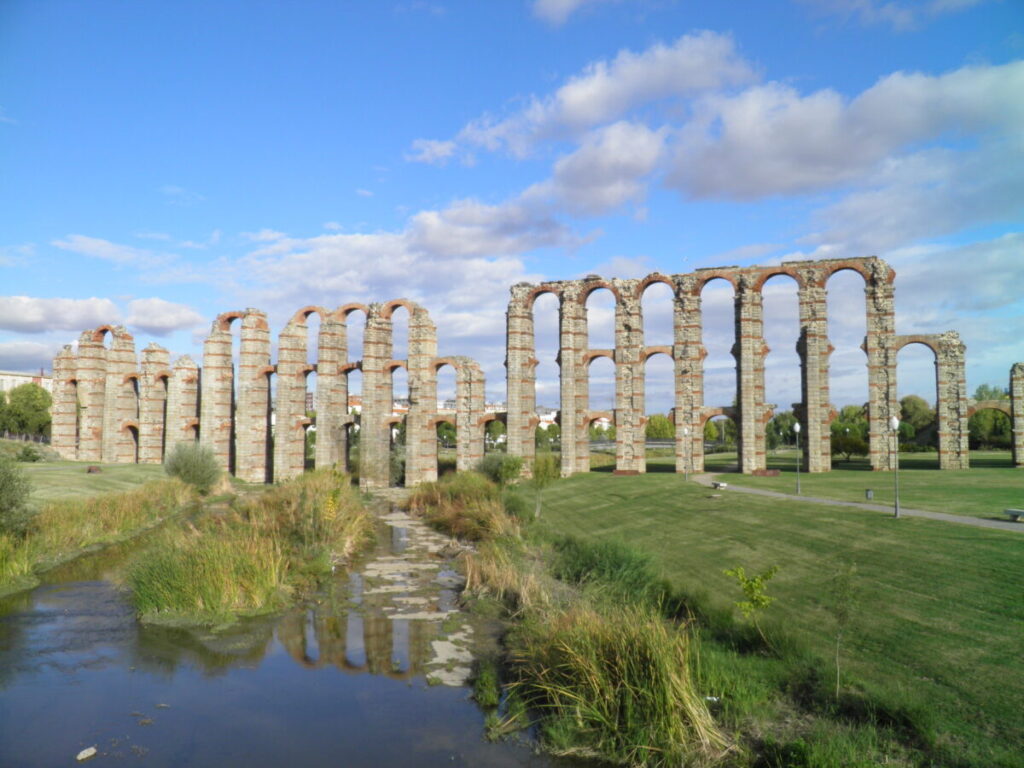
15. The Water Castle – The Heart of Roman Hydraulics
End your walking tour at the Castellum Aquae, a vital component of Mérida’s water distribution system. Located near the ancient Cardo Maximus (the city’s main road), this structure served a functional purpose and flaunted a monumental fountain facade. Today, the Castellum Aquae stands as a fascinating example of how the Romans seamlessly integrated practicality and aesthetics. It’s an evocative site that ties together Mérida’s ancient and modern urban landscapes, reminding visitors of the city’s timeless resourcefulness.
Discover the Best Ruins Near Mérida: A Journey Beyond the City
Mérida, Spain Roman ruins are legendary, but the treasures extend beyond the city. Explore nearby ancient sites that reveal the originality and influence of Roman engineering and culture.
Travel Tip: While exploring the Roman ruins near Mérida, traveling by car is the most convenient option, as public transportation to these sites is limited and primarily seasonal. For those without a car, it’s advisable to consult Google Maps upon arrival to access the most up-to-date information on public transit options or alternative routes.
Proserpina Dam: A Masterpiece of Roman Hydraulics
Just 5 km (ca. 3 miles) north of Mérida, the Proserpina Dam showcases Roman hydraulic brilliance. Built in the 1st century AD, this massive structure once supplied water to the bustling city. Today, it’s a peaceful spot for picnics, fishing, or scenic walks. Standing atop the dam, you’ll marvel at its resilience and historical significance.
How to get there: To visit the Proserpina Dam, you can drive from Mérida in about 10 minutes. Take the Avenida del Lago highway north, then follow signs for the dam, where parking is available nearby. Alternatively, a scenic bike path offers a picturesque cycling option for active travelers.
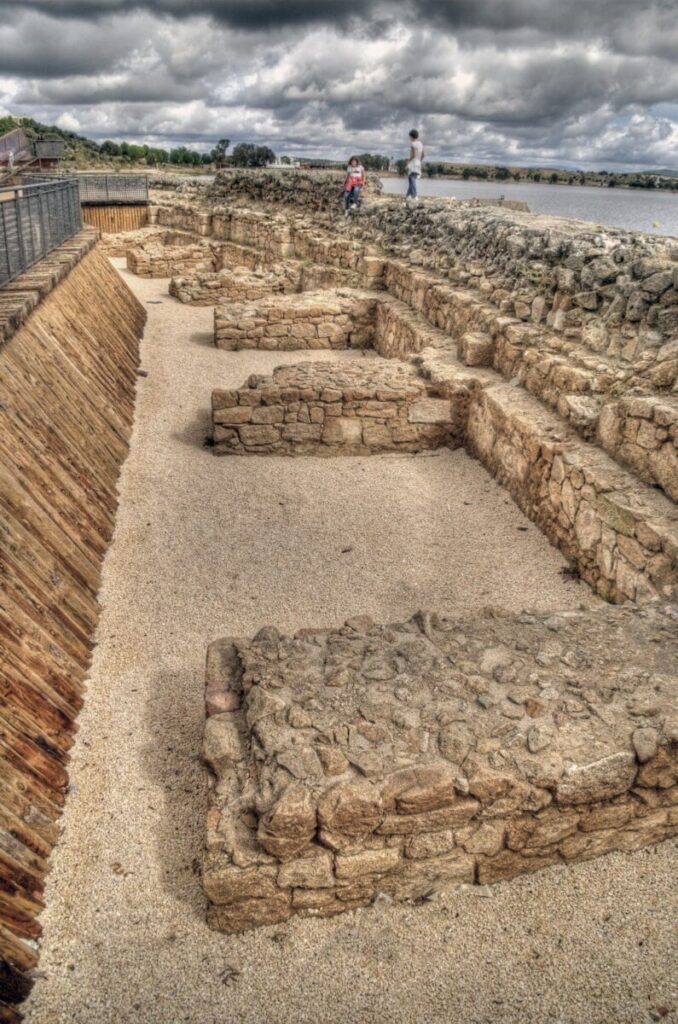
Cornalvo Dam: Engineering for the Ages
Travel 20 km (ca. 12 miles) north to the Cornalvo Dam, another Roman marvel still functioning today. Built in the 1st or 2nd century AD, this is one of the oldest working dams in Europe, standing as a testament to Roman ingenuity and sustainability.
How to get there: Driving to Cornalvo Dam takes approximately 25 minutes. Follow the N-V highway toward Carretera Trujillanos, then continue on the clearly marked route into Presa del Embalse de Cornalvo. Parking is available near the dam. While public transportation is limited, some buses to Trujillanos get you close, leaving a walk through the park to the site. Taxis are also a convenient alternative for direct access.
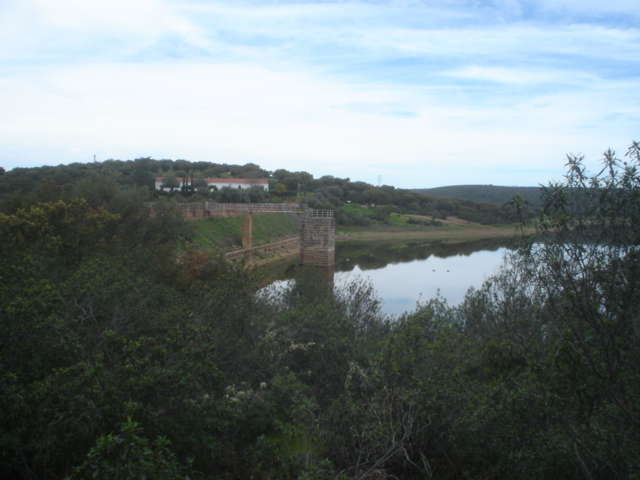
Alange Roman Baths: Relaxation in the Roman Way
Located 20 km (ca. 12 miles) southeast of Mérida, the Alange Roman Baths date back to the 3rd century AD. These thermal baths were a hub of Roman social life and are still in use today. Visitors can indulge in spa treatments while soaking in the ancient atmosphere—a perfect blend of history and relaxation.
How to get there: Reach the Alange Roman Baths by driving southeast along the BA-089, EX-105-A3 and BA-005 highways, a trip that takes about 25-30 minutes. The route is well-signposted, and ample parking is available near the baths. Direct buses from Mérida also run to Alange, with a travel time of 30 minutes, or you can opt for a taxi for a quick and hassle-free journey.
Mérida, Spain Roman Ruins Travel Tips
Where is Mérida, Spain?
Mérida, the capital of Spain’s Extremadura region, is nestled along the north bank of the Guadiana River, about 61 kilometers (ca. 38 miles) east of Badajoz. Its strategic location made it a vital Roman hub, and today, it’s a treasure trove of history, home to some of the finest Roman ruins in Spain.
Conveniently positioned in the heart of the Iberian Peninsula, Mérida is easily accessible from Madrid, Seville, and even Lisbon. Whether you arrive by car, train, or bus, the journey offers scenic views and a gateway to ancient wonders.
When Is the Best Time to Explore Mérida Spain Roman Ruins?
Mérida enjoys a Mediterranean climate with hot summers and mild winters. For the best experience, visit during spring or fall. From April to June and September to October, the weather is comfortably warm, perfect for exploring the Mérida Spain Roman ruins without the scorching heat.
Summer, while hot, offers a unique draw—the Mérida Classical Theatre Festival. This world-renowned event brings the Roman Theatre to life with captivating performances of ancient plays. Watching a drama unfold where Roman citizens once gathered is an unforgettable way to connect with history and culture.
How to Get to Mérida
Reaching Mérida is easy, whether you prefer trains, cars, or buses.
| Trains | Trains from Madrid and Seville offer a smooth journey—about 4 hours from Madrid and 3.5 from Seville. |
| By Car | Average drive time from Seville is 2.5 hours, from Lisbon 3 hours, and from Madrid 3.5 hours. Reserve your car rental at DiscoverCars.com. |
| Buses | For budget travelers, buses provide an affordable and comfortable option, with routes from major cities. Check Flixbus and Busbud for the best bus connections. |
Where to Stay to Visit the Roman Ruins in Mérida Spain
For an unforgettable stay, check into the Parador de Mérida, a former 18th-century convent blending history and comfort. Its central location makes it ideal for exploring ruins near Mérida, such as the Temple of Diana and the Roman Theatre. After a day of discovery, relax with a glass of wine under the stars, surrounded by the charm of ancient history.
Wrap-Up: Where Time Flies Among Mérida’s Ancient Wonders
In Mérida, Spain, tempus fugit—time flies—not because history fades, but because its Roman ruins captivate at every turn. From the grand Theatre to the timeless Puente Romano, the city immerses you in the grandeur of a bygone empire. Mérida weaves its past with modern vitality, offering a destination one cannot easily resist.
Looking for more Roman marvels across Spain? Don’t miss my article: Top 10 Roman Ruins in Spain: An Art Historian’s Guide-Map to Ancient Spanish Sites. It’s packed with inspiration for your next historical adventure. And while the hours may fly as you explore these treasures, the memories you make will linger for a lifetime.
If you enjoyed this post, pin it for later!
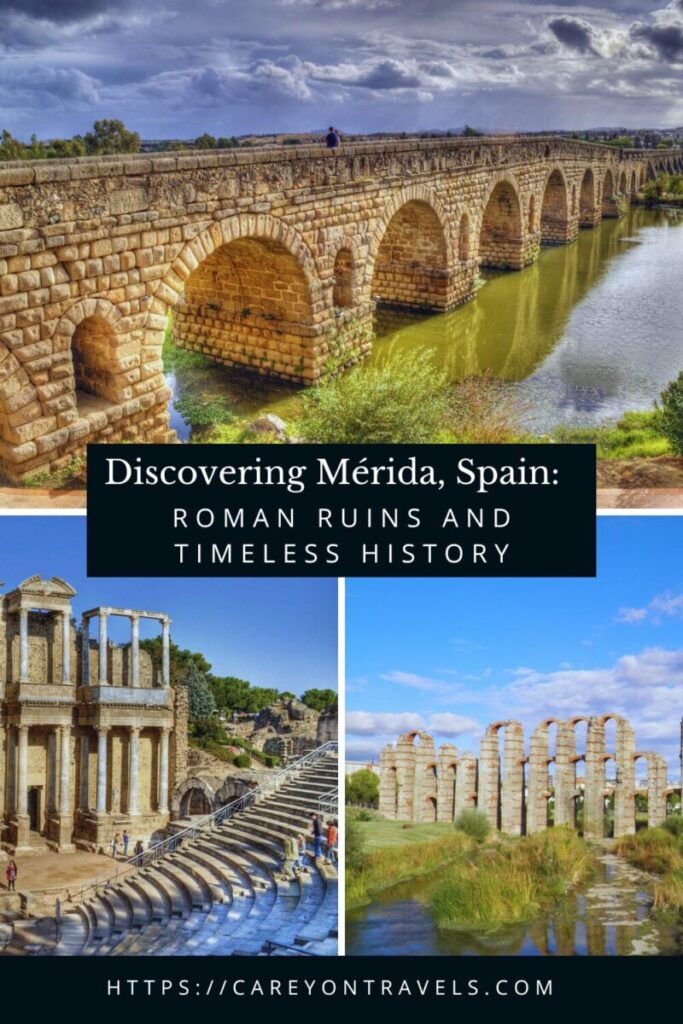
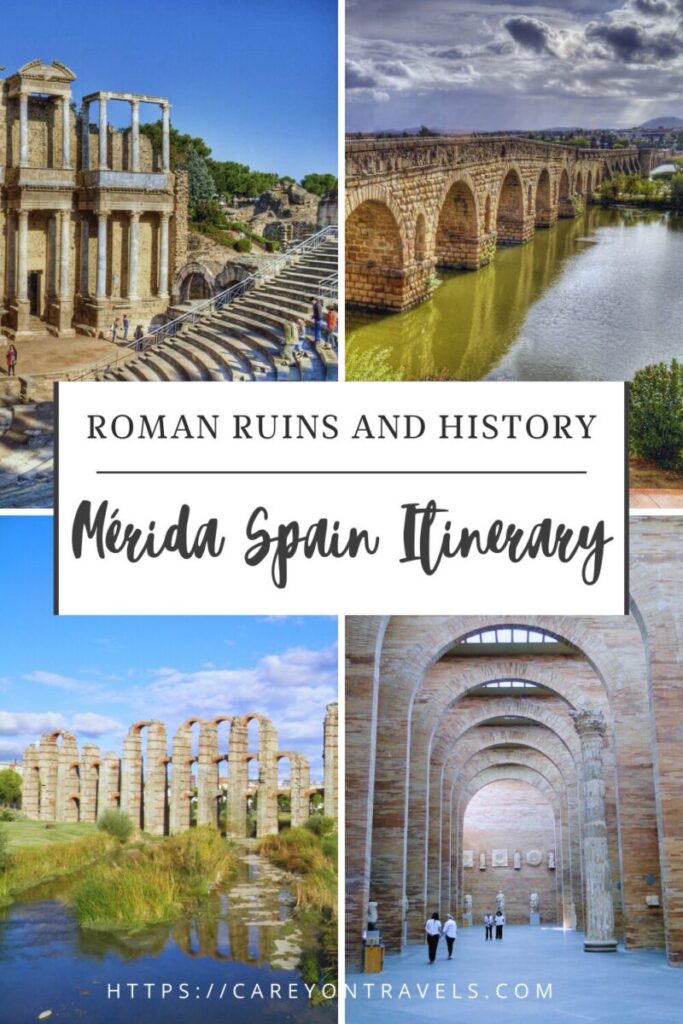
Travel Resources
We recommend booking through our preferred travel booking sites below.
| Air Travel | SkyScanner |
| Lodging | Booking.com, VRBO.com, Expedia.com, Hostelworld |
| Tours and Activities | Viator.com, GetYourGuide.com, TakeWalks.com |
| Car rentals | Discovercars.com |
| Travel insurance | Squaremouth |
| Bike and scooter rentals | BikeBookings.com |
| Train tickets | Trainline, RailEurope |
| Bus tickets | Flixbus, Busbud |

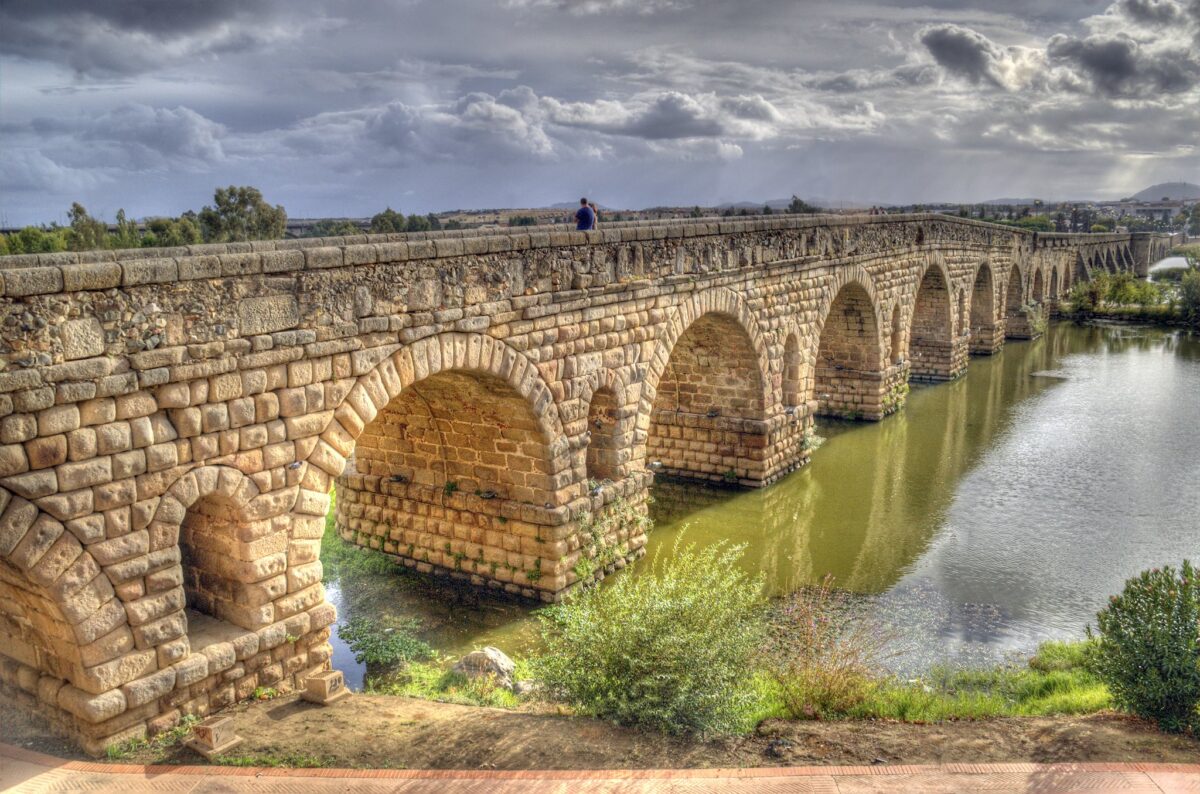





I’ve never traveled overseas, but this location in Spain appeals to me. You may have just changed my mind, Sonia! Great travel post.
Thank you!
Never expected to see Roman ruins in Spain but this sounds like a great off-the-beaten-path idea!
There are quite a few Roman ruins in Spain, but I believe Mérida has the most extensive set of ruins to explore.
Great information! Very detailed and I appeciate that. I haven’t been here, but have thought about it several times for the Roman ruins. I never realized Lisbon was only 3 hours away and I have a trip planned in April to Lisbon, maybe I will make the drive now.
It is an easy trip from Lisbon, and you can stop in Évora or Elvas on the way if you haven’t seen those.
I have not been to Merida but I think I need to. Spain is such a spectacular country, I hope to go again. Thanks for this tip and I am saving it for planning.
Great, hope you are able to visit. It is a side trip from the major cities but definitely worth it.
[…] weeks ago24 comments Share this article FacebookRedditPinterestEmail Previous article Discovering Mérida, Spain: Roman Ruins and Timeless History Next article A Perfect Active Getaway to Brighton UK in Winter Home » Blog » UNESCO » […]
Merida looks absolutely breathtaking! The blend of ancient history and vibrant culture makes it sound so enticing. Definitely adding this gem to my travel list whenever I travel to Spain.
Thank you for the feedback! Mérida has such an extensive set of Roman Ruins to explore. It’s easily reachable from Spain and Portugal too.